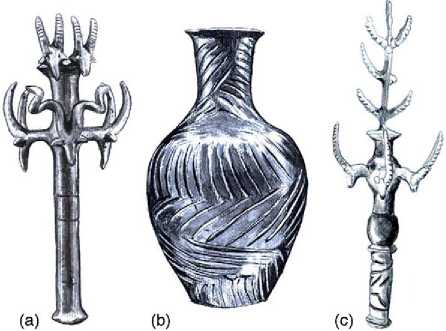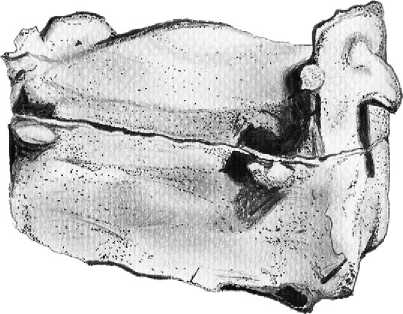Inferences concerning social organization can be made based on the discovery of status symbols and

Figure 3 Cast metal objects: (a) ‘Ibex Standard’ from Nahal Mishmar; (b) vessel from Nahal Mishmar hoard (a and b by J. Golden adapted from Bar-Adon 1980: 44, No. 17; and 107, No. 158); (c) standard from Givat Ha-Oranim (by J. Golden, adapted from Namdar et al. 2004: 5.2:1).
Luxury goods, and the hoard and burial contexts in which they are usually found. The complex metals serve as a good example, where great effort and expenditure went into the production of goods, which in the end, were buried, either in small caches or deep in some burial cave. The cave tombs themselves seem to reflect some form of social hierarchy (see Social Inequality, Development of); a tomb built of mud bricks was recently discovered at the site of Kissufim Road. The wealthier burials often contained a burial ‘kit’ consisting of fancy items made of basalt, ivory, and metal, along with fine ceramics (e. g., Cream Ware) and ceramic ossuaries, or ‘bone boxes’ that are usually decorated (see Figure 4). Nahal

Figure 4 Ceramic ossuary from the Chalcolithic cave tomb at Peqi’in (drawing by J. Golden, after Gal etal. 1999).
Qanah contains the earliest gold in the region along with several copper and copper ‘alloy’ goods, and objects. In most cases, the tombs contained the remains of multiple individuals, suggesting that they were not dedicated to any one individual, but perhaps to certain lineages. Peqi’in, which had at least 250 ceramic ossuaries, and the remains of at least 450 individuals, was probably used over the course of several generations. While the rare exotic goods and rich tombs indicate that not all people had equal access to wealth and status, differences in house size have not been observed at the settlement sites, which might be expected were there marked variation in social status (see Settlement System Analysis; Household Archaeology; Spatial Analysis Within Households and Sites).
It is difficult to say much about political organization in Chalcolithic societies. There has been considerable debate regarding this, with some scholars arguing that there was little evidence for sociopolitical complexity, while others disagree. It is possible that the aforementioned cave tombs contained the burials of political leaders, but it is difficult to distinguish archaeologically between evidence for wealth and power. Nahal Mishmar, where there was a concentration of over 200 metal maceheads, may provide evidence for organized conflict.




 World History
World History









